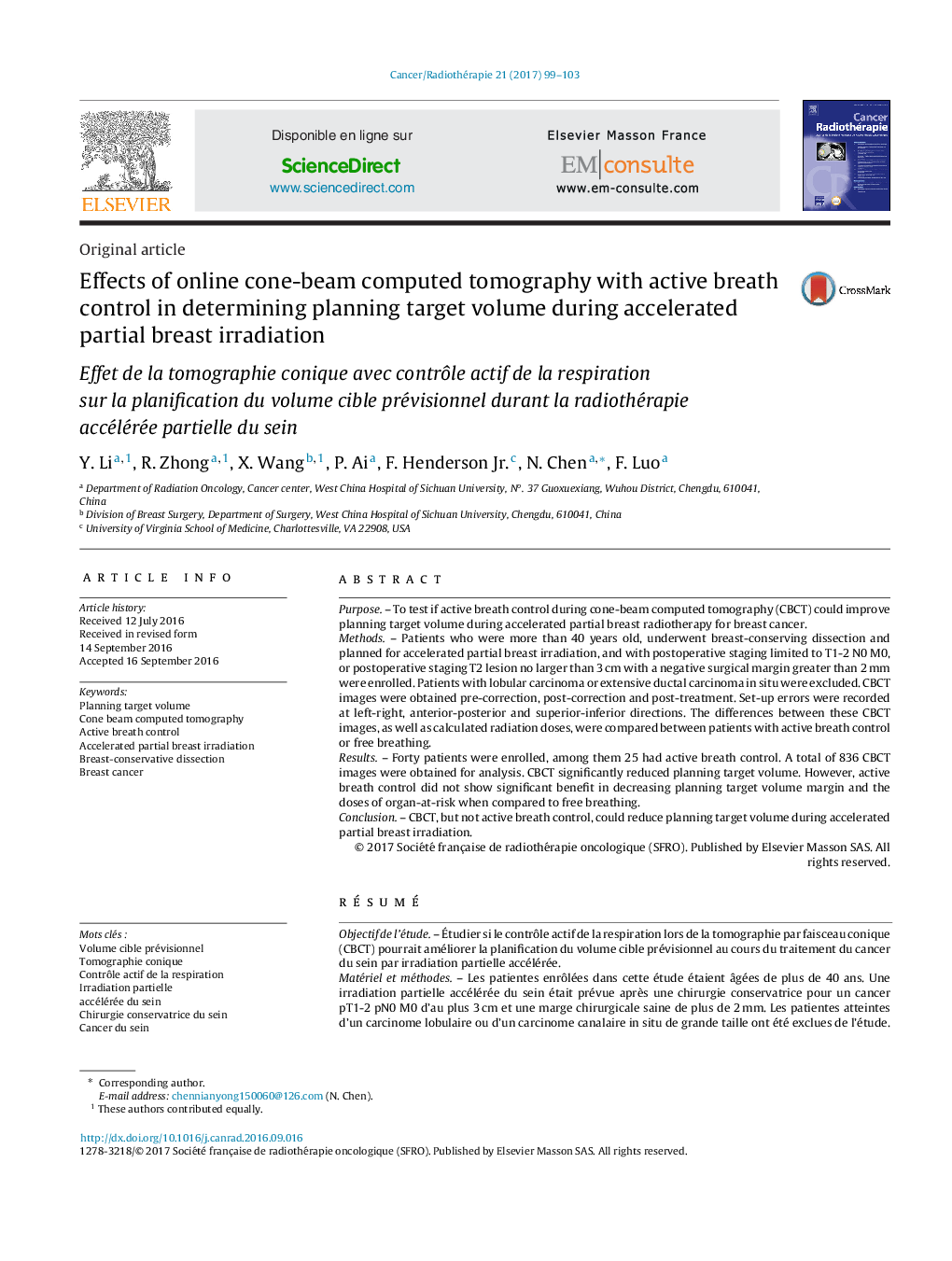| کد مقاله | کد نشریه | سال انتشار | مقاله انگلیسی | نسخه تمام متن |
|---|---|---|---|---|
| 5525917 | 1401506 | 2017 | 5 صفحه PDF | دانلود رایگان |
PurposeTo test if active breath control during cone-beam computed tomography (CBCT) could improve planning target volume during accelerated partial breast radiotherapy for breast cancer.MethodsPatients who were more than 40 years old, underwent breast-conserving dissection and planned for accelerated partial breast irradiation, and with postoperative staging limited to T1-2 N0 M0, or postoperative staging T2 lesion no larger than 3Â cm with a negative surgical margin greater than 2Â mm were enrolled. Patients with lobular carcinoma or extensive ductal carcinoma in situ were excluded. CBCT images were obtained pre-correction, post-correction and post-treatment. Set-up errors were recorded at left-right, anterior-posterior and superior-inferior directions. The differences between these CBCT images, as well as calculated radiation doses, were compared between patients with active breath control or free breathing.ResultsForty patients were enrolled, among them 25 had active breath control. A total of 836 CBCT images were obtained for analysis. CBCT significantly reduced planning target volume. However, active breath control did not show significant benefit in decreasing planning target volume margin and the doses of organ-at-risk when compared to free breathing.ConclusionCBCT, but not active breath control, could reduce planning target volume during accelerated partial breast irradiation.
RésuméObjectif de l'étudeÃtudier si le contrôle actif de la respiration lors de la tomographie par faisceau conique (CBCT) pourrait améliorer la planification du volume cible prévisionnel au cours du traitement du cancer du sein par irradiation partielle accélérée.Matériel et méthodesLes patientes enrôlées dans cette étude étaient âgées de plus de 40 ans. Une irradiation partielle accélérée du sein était prévue après une chirurgie conservatrice pour un cancer pT1-2 pN0 M0 d'au plus 3 cm et une marge chirurgicale saine de plus de 2 mm. Les patientes atteintes d'un carcinome lobulaire ou d'un carcinome canalaire in situ de grande taille ont été exclues de l'étude. Les tomographies coniques ont été obtenues avant correction, après correction et après le traitement. Les erreurs engendrées ont été enregistrées dans les directions gauche-droite, antéropostérieure et tête-pieds. Les différences entre les tomographies coniques ainsi que les doses de radiation calculées ont été comparées entre les patientes avec contrôle actif de la respiration et celles avec respiration libre.RésultatsQuarante patientes ont été inscrites dans le protocole, dont 25 avec contrôle actif de la respiration. Un total de 836 tomographies coniques a été obtenu pour l'analyse. La tomographie conique a conduit à une réduction significative du volume cible prévisionnel tandis que le contrôle actif de la respiration n'a pas montré un avantage important dans la diminution de la marge du volume cible prévisionnel et les doses délivrées aux organes à risque comparativement au groupe de patientes avec respiration libre.ConclusionLa tomographie conique, mais pas le contrôle actif de la respiration, pourrait réduire le volume cible prévisionnel au cours d'un traitement du cancer du sein par irradiation partielle accélérée.
Journal: Cancer/Radiothérapie - Volume 21, Issue 2, April 2017, Pages 99-103
